Summary of web front-end knowledge system
1. Preface
About a few months ago, when I finished reading the book "WebKit Technology Insider", I suddenly had an idea. I want to put all the knowledge required for web front-end development into one view to form a complete web front-end knowledge system. The purpose is to subvert people's understanding that the front-end only has three blocks (html, css, js) Understand - doing web front-end requires much more than these three blocks.
I have been putting it off for several months, but due to an event I am going to attend in the near future, I have to sort this out in the past two days. Just do it. I started sketching in the office in the morning, sorting out ideas in a mess.
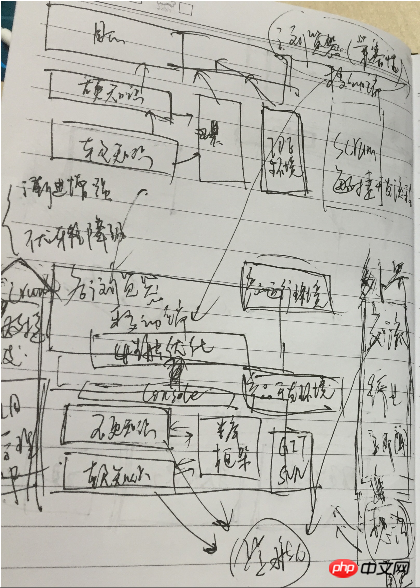
Don’t be afraid. In fact, the knowledge framework below is much more beautiful than the one in the sketch. You can pretend that you haven’t seen the sketch.
Okay, no more nonsense. Please follow the content of my blog below to see what other things need to be mastered step by step in web front-end development in addition to htm, css and js.
Before looking at the content, let’s take a look at the preview of this knowledge framework. The picture is too big to display and cannot be clearly seen. You can download the clear version here: http://pan.baidu.com/s/1hqIUvUc (contains pictures and xmind files of the entire knowledge system)
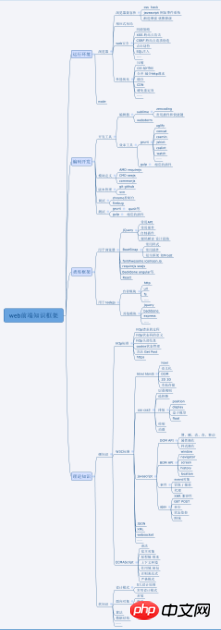
2. Classification
All knowledge frameworks must be a structural display, which is a tree. There are a lot of knowledge points in the web front-end, and they are also very scattered. Several layers of structures are needed to organize the system, otherwise it will look very messy. So how do you organize it and put whom with whom? This is really worth thinking about, and you can also think about this issue yourself.
In the knowledge framework I summarized, first of all, I divided the first layer into: Theoretical knowledge, class library framework, coding development, and operating environment. As shown below:

Next, let me explain to you:
This picture should be viewed from bottom to top, why? ——Because the following is the basis of the above;
First of all, we need certain theoretical knowledge. Whether you listen to others’ lectures, read books by yourself, or search for information online, you need certain theories. Knowledge is inevitable in every program development.
Second, with this theoretical knowledge we can code - yes - but no one can resist the temptation of third-party frameworks and libraries, such as jquery;
Third, with this theoretical knowledge and the class library framework that assists us, we can actually code. You may think that coding development is not just about writing code, what else is there? ——There are many things here;
Finally, the purpose of developing a program is to run it efficiently and stably in the corresponding environment. What are the things we need in this process? Do it? Please look forward to it;
3. Theoretical knowledge includes “soft knowledge” and “hard knowledge”
“Soft knowledge” and “hard knowledge” may seem unfamiliar to you. In fact, everyone will understand it once I say it.
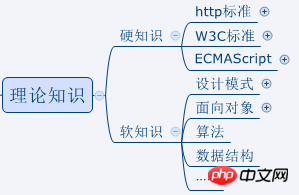
The so-called "soft" refers to the basic skills and internal skills that can be used in various program development, such as data structure, algorithm, and design. Patterns, object-oriented, etc.;
The so-called "hard" ones can be directly used in the development of this program. To use C language, you have to learn C language syntax. Learning Java is useless at this time. The hard knowledge we need for web front-end development is actually included in three standards: http standard, W3C standard and ECMAScript standard;
4. Let’s talk "Hard knowledge" in web front-end development
There is a lot of "soft knowledge", which is also the focus of our study in college (failure to learn well is another matter, and we will make up for it after graduation). We are mainly discussing the direction of web front-end this time, so we will stop here to let everyone know that this knowledge also plays an important role in the knowledge system.
As I just said, there are three standards for hard knowledge: http standard, W3C standard and ECMAScript standard, so let’s talk about these three standards one by one.
4.1 http standard
Why do we need to understand the http standard when doing web front-end? ——Because the browser needs to obtain the web page from the server, the web page may also submit the information to the server, which has an http connection. Since the web system is related to http links, you must understand it.
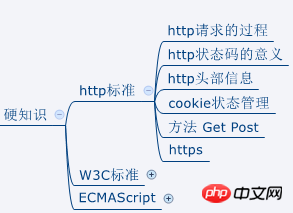
My opinion is: you don’t have to know the details of http very much, but you need to understand some common knowledge of http that is commonly used in web front-end development-that’s me in the picture above Those listed. Of course, I have made an outline of my knowledge, and you have to look up the details yourself (this article talks about the knowledge framework and will not cover the details of any knowledge points)
Regarding this knowledge, it is recommended Check out the book "Illustrated HTTP", which explains these contents in an easy-to-understand manner. I have read it before.
4.2 W3C Standard
If you only know one standard for web front-end, it must be the W3C standard (as far as I know, it seems that most people really only know this one standard) . It has a lot of content, take a look at www.w3.org/TR/.
Writing this reminds me of a sentence: 2/8 principle - 20% of the functions meet 80% of the needs. I think this sentence is very suitable to be used here. We don’t use so many things in our daily development process. Instead, you need to understand the things you usually use a lot.
I don’t think there is any need to explain the knowledge in the picture below. These are the “three big blocks” (html, css, js) that I talk about in article development. Now you have to know that they are only part of the W3C standards, and the W3C standards are only part of the web front-end development knowledge system.
(The picture below is not fully expanded. If you want to see the expanded picture, you can download the attachment provided at the beginning of this article)
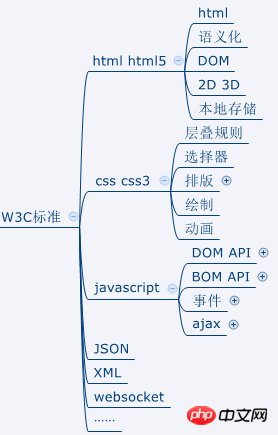
About the basic knowledge of CSS, I would like to recommend my previous blog series: "How much do you know about CSS"
4.3 ECMAScript
The abbreviation of ES is too troublesome to write the full name.
Some people may only know javascript but not ES - in fact, js is based on ES and does some encapsulation for web browsers (added DOM operations, BOM operations, etc.).
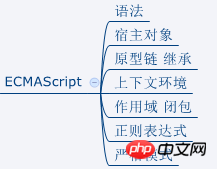
As shown in the picture above, you may usually see these concepts in JavaScript, but in fact they are the content of ES. It's just that javascript inherits these characteristics of ES, and javascript is widely used, so it is discussed more in js.
It’s still the “2/8 principle”. In fact, there is a lot of content in ES, and it is updated very quickly. It has now reached ES6. But these are the most important concepts I listed above. If you don't understand prototypes, closures and scopes, it means you don't fully understand ES, that is, you don't fully know how to use javascript.
I would like to recommend my previous blog series. You can refer to: "In-depth Understanding of JavaScript Prototypes and Closure Series"
5. Frameworks and Class Libraries
The theoretical knowledge required for web front-end development has been described above. How to practice it? ——You can’t act recklessly——You have to go around the world to see which big names have made so many contributions to us.
Using the following libraries or frameworks can greatly improve your development efficiency.
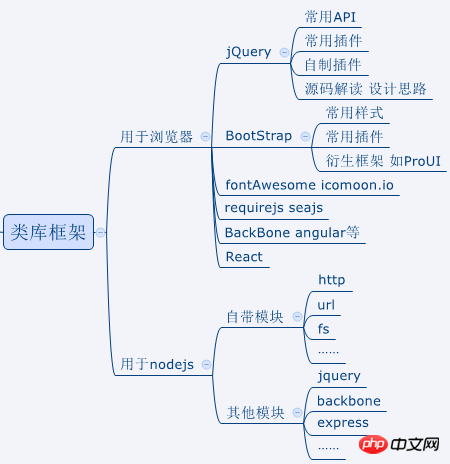
First of all, jquery must be an indispensable tool for most web front-end developers. When I use jquery, I don't just stop at using its API and plug-ins. I also write jquery plug-ins myself. I also read the source code of jquery and understand the design ideas of jquery. If you can do that, trust me, you will get amazing results. If you have a question: How can we understand the JavaScript event system most thoroughly? One of the best answers: Read the source code of jquery’s event processing part several times (you may not understand it once)!
There is no need to explain bootstrap too much. You can see it from the ranking on github. Even our company’s UI designers take screenshots from bootstrap as materials.
fontAwesome is the most powerful icon system in the world. Compared with making icons with CSS, this is many times better, whether in terms of development, efficiency or maintenance. icomoon.io allows me to customize and select my own icon files.
Module definition systems such as requirejs and seajs must also be indispensable in your system. I once watched a tutorial, and the instructor said: requirejs has brought about the second front-end technology change after jquery.
Others, backbone, angular, react, etc. have slowly begun to play their value. I will not go into details here due to limited energy - but they are very important - You have to at least try to understand them.
6. Coding development
If you want to ask which coding IDE is the best, of course it has to be Microsoft’s visual studio! But even the latest version of Microsoft's VS cannot replace the development environment mentioned below.
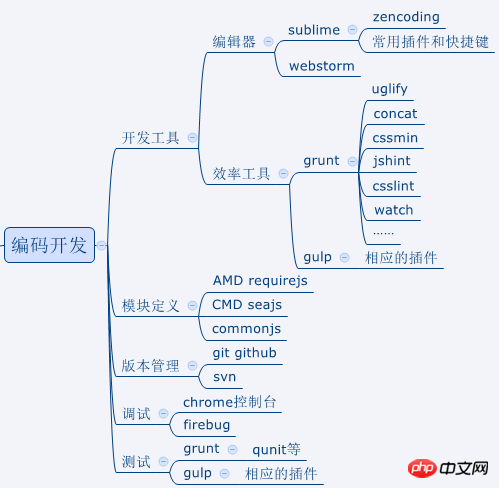
If you specialize in web front-end, don’t use VS anymore, of course choose sublime. Do I still need to write html statements one by one manually? You need the help of zencoding, otherwise the efficiency will be too poor.
In addition, do you still have to do the compression, merging, syntax checking, file clearing, and copying of html, css, and js manually? - You need help from grunt or gulp.
I would like to recommend my own tutorial "Using grunt to build an automated web development environment", which is more detailed and suitable for beginners to learn.
If there are a lot of js codes or files in your system, please choose an appropriate module definition specification - CMD / AMD
Please use git to help you with file version management. The easiest is to use github.
There are also special tools for debugging and testing, all of which need to be learned...
- Oh my God... My hands are sore as I write these words. , don't talk about learning this knowledge - don't say that our web front-end is the "three big blocks" anymore!
7. Running environment
When the system is actually in the running environment, when you feel that it is finally done, there are actually several knowledge points that you need to master. Look at the picture below:

First of all, you need to know that although most of the web systems run under the browser, js may be run in the node environment.
In the browser environment, the two most important points are: web security and performance optimization. I have listed the outlines that need to be paid attention to. If you want to know more, I recommend two books: "White Hat Web Security" and "High-Performance Website Construction Guide"
8. Others
These are all knowledge system. If you want to become a qualified programmer that leaders like, in addition to knowing this knowledge, I think you also need the following points:
To understand the agile software development process (such as SCRUM) and project management knowledge (such as obtaining PMP), this is also a kind of "soft" knowledge;
You must learn to communicate with others online (blogs, QQ groups, Open source projects), communication allows you to see your own shortcomings;
We must learn to self-reflect and self-study. Just like me now, I try to summarize my own things and reflect on them at any time and make progress at any time.
The above is the detailed content of Summary of web front-end knowledge system. For more information, please follow other related articles on the PHP Chinese website!

Hot AI Tools

Undresser.AI Undress
AI-powered app for creating realistic nude photos

AI Clothes Remover
Online AI tool for removing clothes from photos.

Undress AI Tool
Undress images for free

Clothoff.io
AI clothes remover

Video Face Swap
Swap faces in any video effortlessly with our completely free AI face swap tool!

Hot Article

Hot Tools

Notepad++7.3.1
Easy-to-use and free code editor

SublimeText3 Chinese version
Chinese version, very easy to use

Zend Studio 13.0.1
Powerful PHP integrated development environment

Dreamweaver CS6
Visual web development tools

SublimeText3 Mac version
God-level code editing software (SublimeText3)

Hot Topics
 Summarize the usage of system() function in Linux system
Feb 23, 2024 pm 06:45 PM
Summarize the usage of system() function in Linux system
Feb 23, 2024 pm 06:45 PM
Summary of the system() function under Linux In the Linux system, the system() function is a very commonly used function, which can be used to execute command line commands. This article will introduce the system() function in detail and provide some specific code examples. 1. Basic usage of the system() function. The declaration of the system() function is as follows: intsystem(constchar*command); where the command parameter is a character.
 How to implement form validation for web applications using Golang
Jun 24, 2023 am 09:08 AM
How to implement form validation for web applications using Golang
Jun 24, 2023 am 09:08 AM
Form validation is a very important link in web application development. It can check the validity of the data before submitting the form data to avoid security vulnerabilities and data errors in the application. Form validation for web applications can be easily implemented using Golang. This article will introduce how to use Golang to implement form validation for web applications. 1. Basic elements of form validation Before introducing how to implement form validation, we need to know what the basic elements of form validation are. Form elements: form elements are
 How to use Nginx web server caddy
May 30, 2023 pm 12:19 PM
How to use Nginx web server caddy
May 30, 2023 pm 12:19 PM
Introduction to Caddy Caddy is a powerful and highly scalable web server that currently has 38K+ stars on Github. Caddy is written in Go language and can be used for static resource hosting and reverse proxy. Caddy has the following main features: Compared with the complex configuration of Nginx, its original Caddyfile configuration is very simple; it can dynamically modify the configuration through the AdminAPI it provides; it supports automated HTTPS configuration by default, and can automatically apply for HTTPS certificates and configure it; it can be expanded to data Tens of thousands of sites; can be executed anywhere with no additional dependencies; written in Go language, memory safety is more guaranteed. First of all, we install it directly in CentO
 Using Jetty7 for Web server processing in Java API development
Jun 18, 2023 am 10:42 AM
Using Jetty7 for Web server processing in Java API development
Jun 18, 2023 am 10:42 AM
Using Jetty7 for Web Server Processing in JavaAPI Development With the development of the Internet, the Web server has become the core part of application development and is also the focus of many enterprises. In order to meet the growing business needs, many developers choose to use Jetty for web server development, and its flexibility and scalability are widely recognized. This article will introduce how to use Jetty7 in JavaAPI development for We
 How to configure nginx to ensure that the frps server and web share port 80
Jun 03, 2023 am 08:19 AM
How to configure nginx to ensure that the frps server and web share port 80
Jun 03, 2023 am 08:19 AM
First of all, you will have a doubt, what is frp? Simply put, frp is an intranet penetration tool. After configuring the client, you can access the intranet through the server. Now my server has used nginx as the website, and there is only one port 80. So what should I do if the FRP server also wants to use port 80? After querying, this can be achieved by using nginx's reverse proxy. To add: frps is the server, frpc is the client. Step 1: Modify the nginx.conf configuration file in the server and add the following parameters to http{} in nginx.conf, server{listen80
 Real-time protection against face-blocking barrages on the web (based on machine learning)
Jun 10, 2023 pm 01:03 PM
Real-time protection against face-blocking barrages on the web (based on machine learning)
Jun 10, 2023 pm 01:03 PM
Face-blocking barrage means that a large number of barrages float by without blocking the person in the video, making it look like they are floating from behind the person. Machine learning has been popular for several years, but many people don’t know that these capabilities can also be run in browsers. This article introduces the practical optimization process in video barrages. At the end of the article, it lists some applicable scenarios for this solution, hoping to open it up. Some ideas. mediapipeDemo (https://google.github.io/mediapipe/) demonstrates the mainstream implementation principle of face-blocking barrage on-demand up upload. The server background calculation extracts the portrait area in the video screen, and converts it into svg storage while the client plays the video. Download svg from the server and combine it with barrage, portrait
 What are web standards?
Oct 18, 2023 pm 05:24 PM
What are web standards?
Oct 18, 2023 pm 05:24 PM
Web standards are a set of specifications and guidelines developed by W3C and other related organizations. It includes standardization of HTML, CSS, JavaScript, DOM, Web accessibility and performance optimization. By following these standards, the compatibility of pages can be improved. , accessibility, maintainability and performance. The goal of web standards is to enable web content to be displayed and interacted consistently on different platforms, browsers and devices, providing better user experience and development efficiency.
 How to enable administrative access from the cockpit web UI
Mar 20, 2024 pm 06:56 PM
How to enable administrative access from the cockpit web UI
Mar 20, 2024 pm 06:56 PM
Cockpit is a web-based graphical interface for Linux servers. It is mainly intended to make managing Linux servers easier for new/expert users. In this article, we will discuss Cockpit access modes and how to switch administrative access to Cockpit from CockpitWebUI. Content Topics: Cockpit Entry Modes Finding the Current Cockpit Access Mode Enable Administrative Access for Cockpit from CockpitWebUI Disabling Administrative Access for Cockpit from CockpitWebUI Conclusion Cockpit Entry Modes The cockpit has two access modes: Restricted Access: This is the default for the cockpit access mode. In this access mode you cannot access the web user from the cockpit






